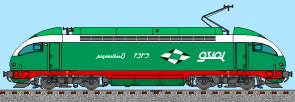IB Turkestan
Getting Around - Inter-city travel
Turkestan is a large state with its major cities at considerable distance from each other. There are various options for getting from place to place within Turkestan. These are detailed here:
By rail:

Probably the best way of getting around in Turkestan is by rail. The inter-city railway network is extensive and efficient, though the lack of a high-speed train similar to the French TGV or Japanese Xincansen means that it can take some time to traverse the country.
The trains are operated by the National Rail Network company, and are almost exclusively electric. Turkestan has abundant clean and cheap electricity, due to its harnessing of the ubiquitous steppe winds with wind turbine generators.
The distinctive teal-liveried trains can be found not only within Turkestan, but also across the borders, particularly in Russian Qazaqstan and Uyguristan.
The trains are operated by the National Rail Network company, and are almost exclusively electric. Turkestan has abundant clean and cheap electricity, due to its harnessing of the ubiquitous steppe winds with wind turbine generators.
The distinctive teal-liveried trains can be found not only within Turkestan, but also across the borders, particularly in Russian Qazaqstan and Uyguristan.
By road:
The highway network of Turkestan is also fairly well-developed, and there are the options both of hiring a car (if your means will stretch that far) or of taking an inter-city bus. Buses are usually considerably slower than trains, but they go to some places that the trains do not, and they are also somewhat cheaper. There are various inter-city bus operators; the best-known and most widespread is Sun Express; Oazis and Azıya Tur are also fairly common.
The roads themselves are classified into Qara Yollar ("Black Roads"), i.e. paved highways, so named because of the black asphalt surfacing usually used on Turkestani roads, and Qoņır Yollar ("Brown Roads"), i.e. unpaved roads. Almost all of the highways are of the Qara Yol type; the highest classification of these are the so-called "Great Roads".
The network of Central Asian Great Roads is similar in concept to the American Trans-Continental Highway system: a network of major arterial roads, many of which cross international boundaries. In the former Snorist bloc, designated Great Roads had special highway code rules to facilitate the movement of traffic, especially military traffic, and most of these rules persist in the post-Snorist world. Among these are the following:
• No stopping of vehicles except in emergencies.
• Priority to be given to military vehicles. If a military vehicle of any kind is coming up behind you to overtake, you are required to pull over so that the military vehicle may pass.
• Large articulated lorries and juggernauts are prohibited from using the inner, "fast" lane, in multiple-carriageway areas. (This rule was and is often more honoured in the breach than in the observance).
• In the Snorist era, there were frequently checkpoints established at many of the network's crucial on/off junctions. Most of these except for the border control points have been removed.
Designated Great Roads are marked with red-painted solid lined along the edges of the road, instead of the yellow edge striping in use on regular highways. Traffic lanes are separated by white dashed lines, and breaks between traffic lanes moving in opposite directions are shown by longer white dashed lines (on single-carriageway stretches) or by solid white lines (on multiple-carriageway stretches).
The red edge striping (as opposed to yellow for regular highways) also informs the driver that Great Road rules are in force. Of these rules (see above), the rule about military vehicle priority is probably the most controversial and most frequently attacked by motoring organisations.
The roads themselves are classified into Qara Yollar ("Black Roads"), i.e. paved highways, so named because of the black asphalt surfacing usually used on Turkestani roads, and Qoņır Yollar ("Brown Roads"), i.e. unpaved roads. Almost all of the highways are of the Qara Yol type; the highest classification of these are the so-called "Great Roads".
The network of Central Asian Great Roads is similar in concept to the American Trans-Continental Highway system: a network of major arterial roads, many of which cross international boundaries. In the former Snorist bloc, designated Great Roads had special highway code rules to facilitate the movement of traffic, especially military traffic, and most of these rules persist in the post-Snorist world. Among these are the following:
• No stopping of vehicles except in emergencies.
• Priority to be given to military vehicles. If a military vehicle of any kind is coming up behind you to overtake, you are required to pull over so that the military vehicle may pass.
• Large articulated lorries and juggernauts are prohibited from using the inner, "fast" lane, in multiple-carriageway areas. (This rule was and is often more honoured in the breach than in the observance).
• In the Snorist era, there were frequently checkpoints established at many of the network's crucial on/off junctions. Most of these except for the border control points have been removed.
Designated Great Roads are marked with red-painted solid lined along the edges of the road, instead of the yellow edge striping in use on regular highways. Traffic lanes are separated by white dashed lines, and breaks between traffic lanes moving in opposite directions are shown by longer white dashed lines (on single-carriageway stretches) or by solid white lines (on multiple-carriageway stretches).
The red edge striping (as opposed to yellow for regular highways) also informs the driver that Great Road rules are in force. Of these rules (see above), the rule about military vehicle priority is probably the most controversial and most frequently attacked by motoring organisations.
By air:
In addition to the international connections, Türkistan Hava Yolları also operates a large number of internal connecting flights and “round tour” airship flights between most of the major cities of Turkestan.

